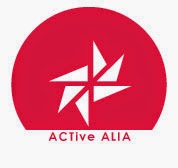Maggie Shapley (ANU archivist) led the tour of the ANU and Noel Butlin Archives on 26 July 2017. A small crowd of librarians and records managers turned up to explore the repository situated over the Parkes Way Tunnel. Maggie explained that the Noel Butlin Archives centre had originally been designed as an underground carpark so it is not designed in its floor loadings to carry the heavy compactuses of purpose built Archives. The staff have done a great job of storing the various collections in archival quality storage boxes and making do with the shelves they had . Various numbering systems has been changed and started by different archivists. Under Maggie a major achievement has been pulling of all these diverse systems into the one relational discovery system.
Maggie and Sarah Lethbridge the Senior Archivist had gone to some pains to draw out interesting items in their collections to show us on the tour and we all enjoyed the show and tell. The Noel Butlin Archives is a mixture of company records and union records so many family historians use the Noel Butlin Archives to find out about their ancestors involvement in certain unions or firms as well as academic researchers doing formal research into such organisations. The range of topics researched include industrial relations, immigration, working women, indigenous employment, architecture, economic history, family history, social history in Australia and the Pacific, and on particular industries such as agriculture, timber, shipping, mining, brewing, advertising and finance The ANU Archives holds corporate as well as personal papers of ANU academics. Several interesting collection items were the research and mapping of the many pubs in Sydney based on the Tooth company records and the pamphlets and photos of the spartan ANU campus and sparse settlement of Canberra of the 1940s used to market ANU and to entice British academics to migrate to Canberra. To me personally a very interesting collection were the unions banners used by various trade unions as part of their Mayday celebrations. I was also intrigued to see the very old minute books of one of Australian’s earliest trade unions , the stone masons of New South Wales. The collection of old sporting trophies from the old forestry school reminded me of the stories my mother an old Canberra girl use to narrate. Learning about how they physically treat the collection by freezing to keep pests like silver fish out was another interesting aspect. It certainly beats reading about such things . The physical process of digitising various memorable papers and other items in the collection was an eye opener for me. Afterwards all of us remarked how much we had gained from going on the tour and discovering for ourselves the ANU and Noel Butlin Archives.





